Sri Lankan Birds
This section features over 30 species of birds commonly found in Sri Lanka.
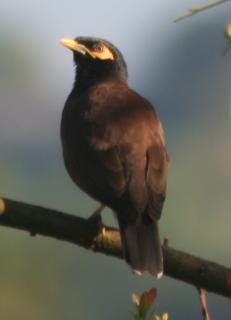
Indian Myna near homes in Kandy |
Sri Lanka has over 400 species of birds, with some 25 of them being endemic (found nowhere else), and others found only in Sri Lanka and India.
All photos were taken in the wild, mostly in Yala National Park. The advantage of getting a photograph, (even a poor one) is that one can sit quietly and study the bird, comparing it to illustrations in bird books, to get an accurate ID. A good photo, of course, is magic!The birds shown below are:
No listing of birds of the Indian sub-continent would be complete without a ubiquitous Indian or Common Myna Acridotheres tristis (above, at top). We first encountered this bird in the islands of Fiji in the central Pacific Ocean, then again in Australia, Indonesia, and SE Asia. This is a brownish bird with black head, neck and breast, a yellow-orange bill, yellow orbital skin (the skin around the eye) and yellow legs. In flight the under wings are conspicuously white, with a white tail tip. Noisy and gregarious, these are probably the most commonly seen and heard birds throughout the country. Indian Mynas nest in holes in large canopied trees, often communally with crows, returning to the same trees for many generations. They are opportunistic feeders, living happily off household scraps, nectar, fruits, large insects such as grasshoppers, geckos and other small lizards. They can be found just about anywhere, especially near human habitation.
|
Camouflaged nicely into the brown and green grassland, the small (19 cm or 7 inches) Indian Pitta Pitta brachyura can be hard to spot. It remains silently feeding on the ground until alarmed at which time it will fly into the always nearby shelter of bushes or trees. When it does call it makes a sharp dual-noted descending whistle. The Indian Pitta is a resident of India and the Himalayas but migrates to Sri Lanka in the winter.
| Perched in the branches of a beach Scaveola bush, we saw this stout female Orange Breasted Green Pigeon Treron bicincta in Yala National Park. The male has similar gray tail feathers and green back with dark gray wing tips but with a lavender band below the throat and a broad orange patch on the upper breast. These pigeons are resident in Sri Lanka and neighboring India and the Himalayas. They prefer moist subtropical broadleaved forest and are fruit eating. | 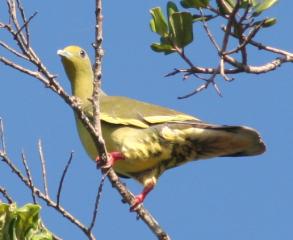 |
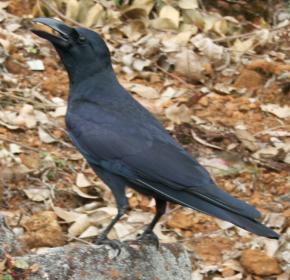
High in the tea fields of central Sri Lanka a Jungle, or Large-Billed Crow Corvus macrorhynchos hopped about between tea plants. These large dark crows are found where ever there are people, always on the look-out for scraps of food. They are aggressive, and will attack even larger animals for food or to protect their young. They make more of a croaking, than a cawing sound, and nest in large colonies, often for many generations. (Sri Lanka tea fields, Haputale).
| On one of the lawns in the Peradeniya Botanic Garden near Kandy we came upon a lovely Red-wattled Lapwing Vanellus indicus. Part of the plover family, this bird is seen fairly commonly near cities and in fields. It is strikingly colored with its black head, neck and breast, with white band on the side neck and red wattle (which gives it its name), white belly and tan back. We used the telephoto lens to "get close" to the bird which was obviously distressed to have anyone walking near it. On closer examination we could see one tan and gray-speckled egg in the grass under the bird. Lapwings eat insects, seeds and tubers, and are usually found in pairs. (Peradeniya Botanic Garden, near Kandy) | 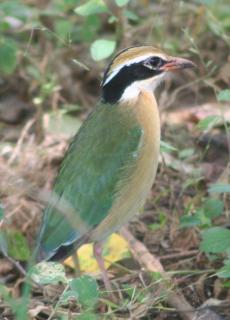
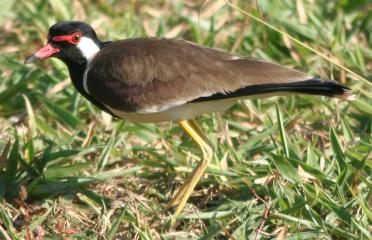
A Red-wattled Lapwing stands guard over its egg. |
|
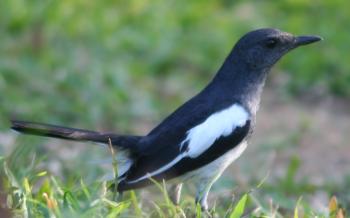 | The Magpie Robin, also known as the Oriental Magpie Robin Copsychus saularis is a very common bird in Sri Lanka and neighboring India. Found in gardens, parks, woodlands and open forest it often announces its presence with a lovely "swee-ee" song. The female is similar to the male although the black back, head and tail may appear more gray. It is often seen on the ground, hopping about for insects. (Peradeniya Botanic Garden, near Kandy) |
|
|






No comments:
Post a Comment